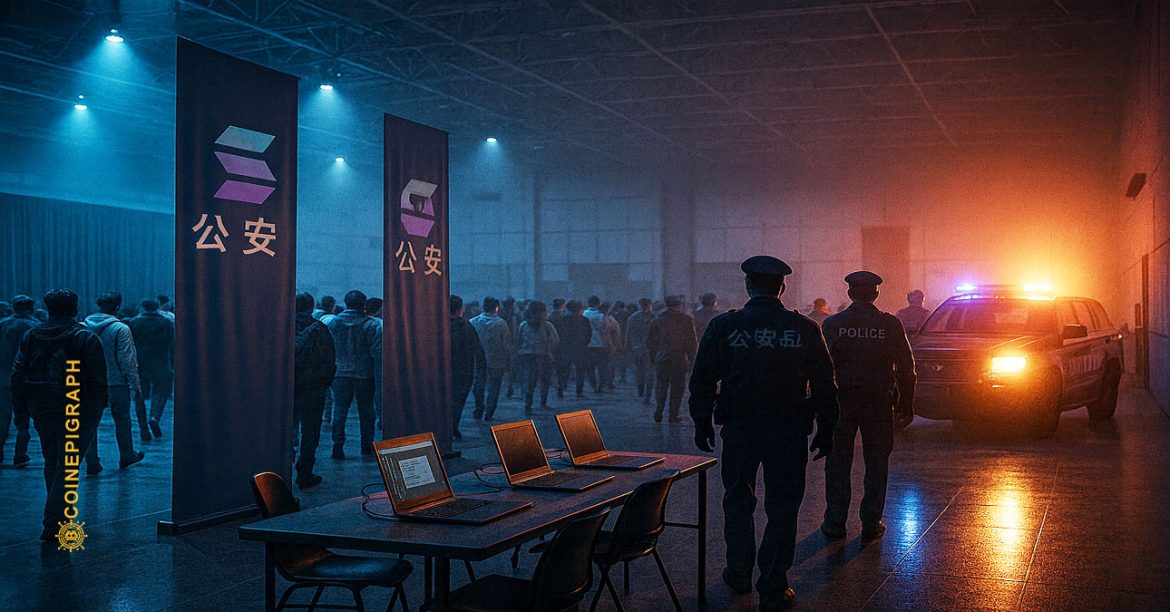By CoinEpigraph Editorial Desk
In Shenzhen this week, the Solana community’s “Accelerate APAC” meetup came to an abrupt end. Organisers confirmed the venue had exceeded capacity and cancelled the final hackathon session for “public safety.” Yet the shadow on the ground was more than overcrowding: local attendees reported police inquiry, social-media unease and whispered regulatory alarm.
While the disruption is being officially attributed to capacity issues, the timing could not be more sensitive. Just days before, the People’s Bank of China (PBoC) reiterated warnings about stablecoins and private digital-asset speculation — and the Chinese market remains under a blanket ban on retail crypto trading.
For Solana, a network that has made in-roads into developer outreach in Greater China, the incident is a reminder that innovation may still bump against regulatory control. And for global crypto markets, it suggests how quickly local operational rhythms can shift under regulatory pressure.
When Overcrowding Becomes a Signal
At the core of the story is this: what looked like a success — hundreds of developers and builders filling a Shenzhen venue — ended in an unplanned shutdown. According to the Chinese Solana community’s social post, “A few friends who were denied entry reported the event, leading local police to conduct an inquiry on site.”
On the surface: organisers cited public-safety hazards and “overcapacity”. But for participants, the unexpected police presence and the abrupt cancelation of the hackathon demo raised questions: in a market that formally bans crypto trading, what happens when a global protocol holds a large gathering?
The event’s timing matters. China has outlawed crypto trading and mining; blockchain gatherings and hackathons have persisted only in controlled forms. When an event of this scale attracts police action, developers interpret it as more than logistics. It becomes a regulatory bell-wether.
China’s Regulatory Winter Meets Global Growth
While developers were exiting the Shenzhen event, the Solana token (SOL) was quietly finding institutional traction elsewhere. U.S. product launches such as the staking-enabled Solana ETFs by Grayscale Investments and Bitwise Asset Management are gaining investor attention. (TradingView)
The result: a two-speed model emerges. On one side, China’s enforcement is tightening; on the other, Western institutions are embracing Solana as a tradable, staking-yielding network. That divergence deepens the geopolitical pull on crypto infrastructure: nodes, developers, and capital increasingly ask where innovation can thrive — not just where it can launch.
What It Means for Solana (and Other Chains)
For the Solana ecosystem, the Shenzhen disruption introduces three immediate considerations:
- Developer sentiment and regional access
Hackathons and developer outreach are key growth levers for Solana. When an event ends under police inquiry, even if for crowd-control reasons, it can dampen local initiative and deter future activity in that region. - Regulatory risk for “glocal” networks
Solana bills itself as global and open, but its exposure to markets like China means any regulatory shift there can ripple worldwide. The venue incident may serve as a cautionary tale for other networks hosting large gatherings in jurisdictions with opaque rules. - Narrative leverage for institutions
The contrast between Chinese friction and U.S./Hong Kong institutional adoption becomes a speaking point: “Look where Solana is being hosted vs. where it’s being curtailed.” That duality might influence where capital and talent flow next.
A Case Study in Regulatory Timing
The Shenzhen episode may not be the headline itself. The real story lies in the signal it sends: that even networks with major global backing can face operational friction if regulatory tolerance wavers.
Developers, investors and ecosystem builders should interpret the timing as a risk gauge. If a large-scale Solana event in a major Chinese city can be curtailed without warning — then gathering size, local permits, and authorities’ tolerance become meaningful variables for any protocol’s regional strategy.
For Solana, the event may ultimately pass without major fallout. But for the broader crypto industry, it is another data point in a growing dossier of regulatory-novation mismatches: where innovation moves ahead of policy, but occasionally policy reclaims the field.
At Coinepigraph, we pride ourselves on delivering cryptocurrency news with the utmost journalistic integrity and professionalism. Our dedicated team is committed to providing accurate, insightful, and unbiased reporting to keep you informed in the ever-evolving crypto landscape. Stay tuned as we expand our coverage to include new sections and thought-provoking op-eds, ensuring Coinepigraph remains your trusted source for all things crypto. -Ian Mayzberg Editor-in-Chief
The team at CoinEpigraph.com is committed to independent analysis and a clear view of the evolving digital asset order.
To help sustain our work and editorial independence, we would appreciate your support of any amount of Bitcoin/Satoshi to this address below: 3NM7AAdxxaJ7jUhZ2nyfgcheWkrquvCzRm
and through our Support Page.
🔍 Disclaimer: CoinEpigraph is for entertainment and information, not investment advice. Markets are volatile — always conduct your own research.
COINEPIGRAPH does not offer investment advice. Always conduct thorough research before making any market decisions regarding cryptocurrency or other asset classes. Past performance is not a reliable indicator of future outcomes. All rights reserved 2024-2025.




